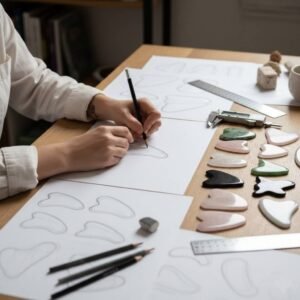Does gua sha hurt your face? Despite being a technique proven to be safe and low-risk over thousands of years of development, improper use of scraping can still cause harm. Especially in its new application for facial beauty, incorrect usage can damage your face. Here are some factors that might lead to scraping harming your face:
- Using Inferior Gua Sha Hurt Your Face
- Gua Sha Medium Can Also Hurt Your Face
- Incorrect Techniques of Gua Sha Hurt Your Face
Using Inferior Gua Sha Hurt Your Face

gua sha tools, being items in direct contact with your skin, even with minor flaws, can harm your face. Therefore, when purchasing gua sha tools, make sure they meet the requirements. Here are phenomena commonly found in substandard gua sha products:
- Inferior Material: Some unscrupulous sellers might use subpar materials, such as plastics containing harmful substances, metals, or processed stone materials, exceeding the standard for harmful substances. These materials can cause discomfort, redness, swelling, and even skin lesions when in contact with your face.
- Flaws on the Surface: Surface cracks can cause open wounds on your face, which usually heal quickly without leaving scars. So, inspect the gua shatool’s surface for obvious cracks, especially around the edges in direct contact with your face.
- Inappropriate Shape: Different gua shashapes are suitable for various body areas. Using a tool designed for other areas on your face could cause injuries, especially if it has sharp structures meant for concentrated gua sha.
When purchasing gua sha tools, choose shapes and sizes suitable for facial gua sha.
Gua Sha Medium Can Also Hurt Your Face
Various liquid mediums are used during gua sha for lubrication and enhanced effects. However, using inappropriate mediums can have adverse effects:
- Allergic Factors: Some people might be allergic to elements in gua shamediums, leading to itching, redness, and swelling. Conduct an allergy test before using if you are unsure.
- Mismatched Lubricants: Using oily mediums on oily skin might yield contrary results. Choose mediums suitable for your skin type, like water-based mediums for oily skin and oily mediums for dry skin.
Incorrect Techniques of Gua Sha Hurt Your Face

Improper usage is the most common reason for facial injuries. For instance, incorrect angles or excessive force can cause harm. Here’s how to correctly use gua sha tools on your face:
- Proper Grip: Hold the tool at a 15-degree angle to your skin. Apply enough pressure to feel the tool on your skin but avoid excess pressure to prevent discomfort or pain.
- Start from the Neck: Begin from the neck and move up to the forehead. Scrape gently upward in one direction, following the natural contours of your face and neck.
- Be Gentle Around Sensitive Areas: Avoid active acne, open wounds, or highly sensitive skin areas. Be delicate around the eyes and mouth to prevent bruising or skin damage.
- Focus on Pressure Points: Pay attention to pressure points like the jawline, temples, and brow bones. Apply slightly more pressure but ensure your movements remain gentle.
- Moderate Pressure: gua shashould not be painful. Apply enough pressure to release tension but avoid causing harm. If it hurts, you’re exerting too much force.
- Repeat as Needed: You can repeat each stroke 3-5 times or more if necessary, but avoid excessive gua sha, especially if you’re new to it. Start with a few strokes and gradually increase if comfortable.
- Clean the Tool: After each use, clean the gua shatool with mild soap and warm water to remove oils or residues. Ensure it’s thoroughly dry before storing it.
Follow these methods. For more visual guidance, there are numerous tutorials available on platforms like YouTube. Feel free to refer to them for hands-on instructions.
In summary, the probability of gua sha hurt your face is low but not zero. However, by using the correct methods and choosing the right tools, you can significantly reduce this probability. If you still have questions, please leave a comment, and we’ll promptly respond to your inquiries.






